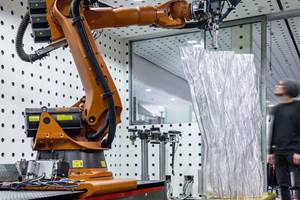Avio Utilizes Velo3D Metal Printers for Developing Propulsion Systems
The Italian space propulsion innovator is installing the printers in its Colleferro, Italy, headquarters to produce mission-critical parts for its family of rocket engines.
Velo3D CEO Benny Buller (fourth from left) and members of the Avio and Velo3D teams at the Paris Air Show. Photo Credit: Velo3D
Italian aerospace company Avio has purchased a Velo3D Sapphire XC 1MZ metal printer and an original Sapphire printer to support the development and production of its propulsion systems to accelerate the advancement of the space industry. Velo3D’s solution was selected for its ability to produce quality parts with optimized geometries for the highest performance, and the large build volume of the Sapphire XC 1MZ. Both printers are calibrated to produce parts in nickel-based alloy which delivers strength and corrosion resistance at extreme temperatures.
Avio works on making space more accessible and affordable. With a strong focus on propulsion systems, Avio has delivered competitive solutions for launching institutional, governmental and commercial payloads into orbit through its Vega family of launch vehicles. By adopting Velo3D's fully integrated solution, Avio aims to achieve new milestones in design quality and time-to-market for its products.
With one of the largest build volumes for laser powder bed fusion 3D printers, the Sapphire XC 1MZ 3D printer has a print volume that is 600 mm in diameter and 1,000 mm in height. The original Sapphire has a print volume of 315 mm in diameter and 400 mm in height. Both printers enable Avio to overcome the constraints of traditional manufacturing methods, including conventional additive manufacturing solutions. The printers accomplish this by providing a wide breadth of geometric design freedom and a high degree of precision.
The printing solution from Velo3D empowers Avio to optimize its designs and manufacture quality, high-performance components with intricate geometries that were previously unattainable. The result is improved performance, reduced weight, enhanced reliability and, ultimately, a more efficient and accessible space industry.
“Avio is one of the leading space companies in Europe and we are thrilled to partner with them in their pursuit of groundbreaking propulsion systems,” says Benny Buller, founder and CEO of Velo3D. “They work with some of the most innovative companies and agencies in Europe and around the world to provide them with the technology they need to reach space. The Sapphire XC 1MZ will help Avio further accelerate the development of its propulsion systems and contribute to the ongoing transformation of the space industry.”
The cooperation between Avio and Velo3D comes at a pivotal moment in the growing space industry, which is witnessing transformative advancements. With the advent of 3D printing, the industry has gained momentum by enabling faster time-to-market, distributed supply chains, part consolidation and enhanced performance capabilities. Velo3D is one of the leading 3D printing providers enabling new space companies, with customers that include SpaceX, Launcher and other innovators.
- Learn about Velo3D’s Flow 5.0 Software which is said to enhance control over the 3D printing process. The software’s new features include user-selectable core parameters, preprint analysis to identify potential costly and time-consuming errors, and rapid resequencing for multipart prints.
- Read about Velo3D’s partnership with PhysicsX to provide engineers with AI simulation tooling. The collaboration gives Velo3D customers access to AI-enabled physics simulation and optimization capabilities, and gives PhysicsX customers increased manufacturing flexibility to produce their most advanced concepts.
Related Content
8 Cool Parts From Formnext 2023: The Cool Parts Show #65
New additive manufacturing technologies on display at Formnext were in many cases producing notable end-use components. Here are some of the coolest parts we found at this year’s show.
Read MoreVideo: AM for Repair of Large Shafts
Wind power shafts that might once have been scrapped are now returned to service. See the robotic directed energy deposition (DED) and shaft preheating system developed by Ikergune, Izadi and Talens.
Read MoreVideo: Construction 3D Printing with Robotics, Geopolymer
Alquist 3D is aiming to revolutionize construction and infrastructure with large-format robotic 3D printing using a carbon-neutral material.
Read More3D Printing Brings Sustainability, Accessibility to Glass Manufacturing
Australian startup Maple Glass Printing has developed a process for extruding glass into artwork, lab implements and architectural elements. Along the way, the company has also found more efficient ways of recycling this material.
Read MoreRead Next
Profilometry-Based Indentation Plastometry (PIP) as an Alternative to Standard Tensile Testing
UK-based Plastometrex offers a benchtop testing device utilizing PIP to quickly and easily analyze the yield strength, tensile strength and uniform elongation of samples and even printed parts. The solution is particularly useful for additive manufacturing.
Read MoreAlquist 3D Looks Toward a Carbon-Sequestering Future with 3D Printed Infrastructure
The Colorado startup aims to reduce the carbon footprint of new buildings, homes and city infrastructure with robotic 3D printing and a specialized geopolymer material.
Read MorePostprocessing Steps and Costs for Metal 3D Printing
When your metal part is done 3D printing, you just pull it out of the machine and start using it, right? Not exactly.
Read More





















